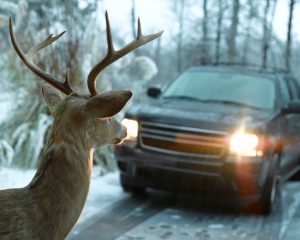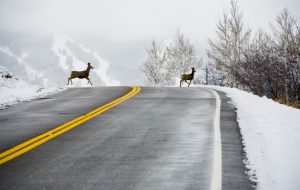Wintertime means deer season in Connecticut, and for drivers, this means a new hazard could be lurking around the corner. If you aren’t prepared to handle the wild fauna that refuse to obey the rules of the road, you could wind up in a dangerous situation. While many instinctively panic and swerve away from animals like deer in the road, a recent news report advised against this. There is a safer way for Connecticut drivers to handle deer on the road.
 When Animals Cross the Road
When Animals Cross the Road
December marks the end of mating season for deer. Not even the blinding headlights and whirring sounds of a busy road will stop these animals from fulfilling nature’s intentions. Deer season also coincides with Daylight Savings Time, when days become darker much earlier and road visibility is reduced to a minimum. These factors combined can make for dangerous road conditions, but proper preparation could help you avoid a devastating vehicle collision.
Tips To Avoiding a Car Accident
Don’t be caught off-guard this winter. Stick to a plan so that you’re ready to handle whatever comes your way.
The following tips will help you stay safe behind the wheel during deer season:
- Always keep your eyes ahead while scanning the road and shoulders ahead of you.
- If there is no oncoming traffic, use your high beam headlights to illuminate deer down the road.
- Be cautious at dawn and dusk, when animals are most active.
- Wear your seat belt and drive sober.
- Never drive faster than you can see.
- The lower your speed, the more time you’ll have to react and avoid a deer collision.
If a Collision is Unavoidable

Even when exercising caution, you could be faced with an unavoidable collision. If a deer darts out in front of your car and you have no time avoid the crash, experts advise against swerving to avoid the deer.
Swerving could send you into side road obstructions such as walls, rocks, railing or trees and worse, could send you into oncoming traffic on a two-way highway. Your safest option may actually be to hit the animal.
The AAA, Connecticut State Police and numerous insurance companies have issued the following tips to help you handle a collision with a large animal. If you are about to hit an animal blocking the roads, follow the steps below.
- Slow down safely by letting off the brakes before impact. When a vehicle brakes, the front end of the car drops down, increasing the odds of the animal rolling up onto the hood and potentially hitting the windshield.
- Turn on your hazard lights to warn potential traffic behind you.
- Do not swerve to avoid a collision. You could travel into oncoming traffic.
Keep This in Mind
The most effective way to avoid a deer collision is always to slow down. The more control you have over your speed, the more time you will have to avoid hitting an animal. Practice safe driving to keep yourself and others out of harm’s way during deer season.
